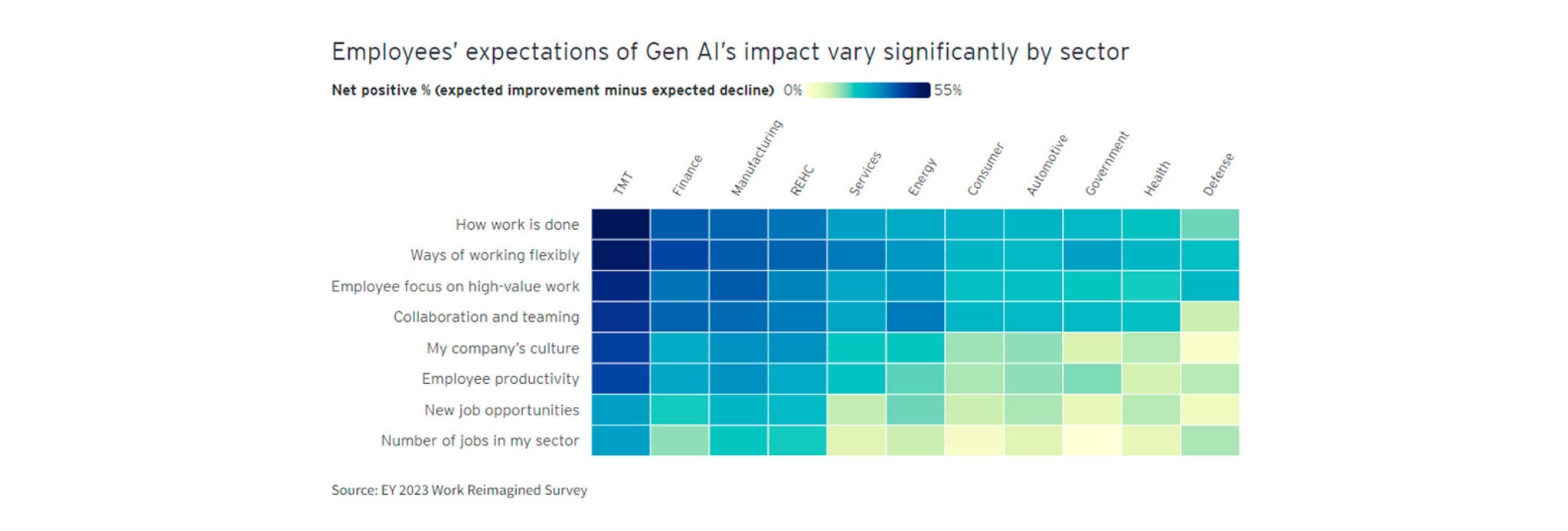EY refers to the global organization, and may refer to one or more, of the member firms of Ernst & Young Global Limited, each of which is a separate legal entity. Ernst & Young Global Limited, a UK company limited by guarantee, does not provide services to clients.

Organizations’ journey toward a sustainable future begins with high-quality data that is seamlessly integrated in people's day-to-day work.
In brief
- Access to high-quality data requires well-established procedures to collect data along with a proper platform to store and analyze data.
- Seamlessly integrating data with employees’ day-to-day work environment will enable them to make informed choices to support carbon neutrality objectives.
Have you ever wondered how technology can shape the future of sustainable work environments? The EY 2023 Work Reimagined Survey reveals there is a 33% net positive sentiment of employers and employees who believe generative AI (GenAI) will boost productivity and new ways of working, and an even greater 44% net positive of those who expect the technology to enable greater flexible working. The report highlights how generative technologies can add value to the human experience of work.

As we explore sustainability in the Future of Work strategies, Bytes is a pivotal aspect of the Bricks, Bytes and Behavior framework. The Bytes component encompasses the digital infrastructure, data analytics, and technological innovations that power our workplaces. When seamlessly integrated into our daily workflow, Bytes becomes a powerful catalyst for sustainability initiatives.
Data: the core of sustainability
ESG or sustainability, in many ways, is a data problem. From a Future of Work perspective, deciding whether employees should travel by bus or train or not travel at all is dependent on having the relevant data. It is also significant to understand which areas of an organization’s activity have the greater material impact on carbon footprint. According to the European Sustainability Reporting Standard (ESRS) and Corporate Sustainability Reporting Directive (CSRD) requirements, organizations are required to focus on material topics. For instance, in some organizations, employee commute may not contribute significantly to the overall footprint compared to other operational aspects.
Highlighting technology's pivotal role in utilizing data for sustainability in employees' daily activities, "Bytes” can drive sustainable choices, positively impacting employee wellbeing within broader sustainability efforts.
Max Österlund
Nordic program and project management competency area leader, Technology Consulting, EYs Amplifier, EY Norway
Building an ESG data foundation
While data is critical to sustainability, it is often not available or of satisfactory quality. When the data is available, it requires the necessary cleansing, validation, enrichment and transformation before it can provide value. This is where an ESG data foundation or a data platform comes into the picture. Next, organizations need to figure out where to find the data and establish procedures for capturing the data, importing it into the platform, transforming the data and ensuring data quality. What is also needed is a carbon calculation engine that can be used to perform calculations on carbon footprint. These curated datasets can then be made available for different tools, business applications, analytics and dashboards. The ESG data foundation enables scaling and customization of your tech stack so that you can drive green action and reduce carbon emissions as part of your net-zero transformation journey.
Having a proper data foundation along with data governance also ensures that data is “assurance ready” in accordance with CSRD.
Establishing procedures to capture data
Data capture procedures require focus both at a functional and at an individual level. For example, in procurement, when you choose a supplier, how do you know that a given supplier will support you in your journey to becoming carbon neutral? This will require collecting data on suppliers’ carbon footprint with respect to various products and services.
In procurement, for instance, assessing a supplier’s commitment to carbon neutrality involves collecting data on their carbon footprint across their value chain. Similarly, data collection during project deliveries, such as tracking travel, becomes pivotal. Understanding individual contributions to an organization’s ESG goals necessitates collecting data on an individual’s carbon footprint, covering activities like commuting or the use of meeting rooms. This collective data is then integrated into the data foundation or platform, enabling the creation of various “data products” tailored to the specific needs of the organization.
Utilizing data to “nudge” carbon-efficient actions
Once a robust data platform is available, data collected from various streams either manually or through various IOT sensors needs to be made readily available, integrating it with people’s day-to-day work. The overall experience needs to be made as smooth as possible. Access to data-driven insights will enable people to make informed choices to do the right thing.
Engaging people is important, people need to know the “why”. Why should they be a part of this or why should they try to change behaviors? For example, empowering people with information can be helpful in increasing reuse or extended use of electronic equipment. The trend of replacing mobile phones every couple of years could be limited. Often people replace their phones every two years, even though they are quite happy with what they have been using. Giving people information on the carbon footprint of a new phone can be helpful in nudging them to delay replacing their phones.
Another example could be to publish the carbon footprint of various menu items in the office canteen, so people can make informed decisions on the food they consume. At the EY office in Oslo, an effort is being made to have more plant-based foods and to ensure that people do not take more food than they need. Reducing food waste is important in trying to reduce carbon footprint.
Technology guides employees to sustainable choices by leveraging data-driven insights. Embedding sustainability into procurement, meeting room choices, and daily activities cultivates an environmental consciousness culture at work.
Daniel Karlsson
Associate Partner, Technology Consulting, EY Sweden
Leveraging digital technology
As people transition toward hybrid work environment in the post-COVID-19 era, efficient utilization of office resources can be an important lever to improve carbon efficiency. Having the right tools can help to level the office utilization on different weekdays while still promoting adequate collaboration in the team. Also, some of these tools can be built to ensure proper utilization of meeting rooms.
For instance, if a room is designated for 10 people, and only four team members are present in the office, opting for a digital meeting may be more sustainable. Another strategy involves promoting asynchronous work. While frequent meetings require synchronization, task delegation fosters asynchronous work, allowing individuals to complete tasks at their convenience. This approach, common among software developers with brief synchronous meetings, contributes to the sustainability of hybrid work from a people's wellbeing perspective.
Contact us today to learn how you can successfully integrate sustainability into your Future of Work strategy.
Summary
Organizations need to make access to sustainability data as simple as possible and integrate it with employees’ work environment. Use of technology can greatly enable people to make informed choices to support an organization’s efforts toward a sustainable future.


